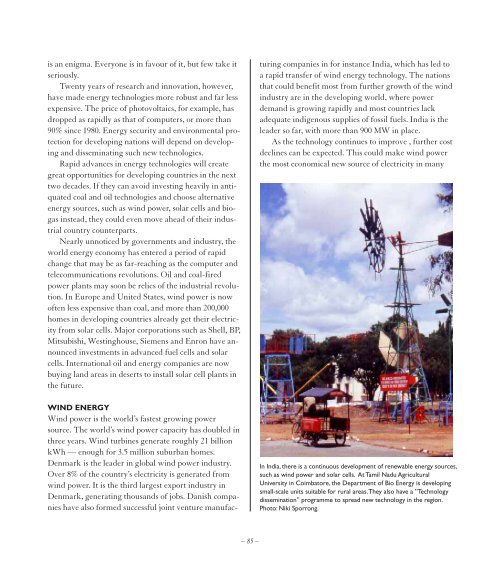Create successful ePaper yourself
Turn your PDF publications into a flip-book with our unique Google optimized e-Paper software.
is an enigma. Everyone is in favour of it, but few take it<br />
seriously.<br />
Twenty years of research and innovation, however,<br />
have made energy technologies more robust and far less<br />
expensive. The price of photovoltaics, for example, has<br />
dropped as rapidly as that of computers, or more than<br />
90% since 1980. Energy security and environmental protection<br />
for developing nations will depend on developing<br />
and disseminating such new technologies.<br />
Rapid advances in energy technologies will create<br />
great opportunities for developing countries in the next<br />
two decades. If they can avoid investing heavily in antiquated<br />
coal and oil technologies and choose alternative<br />
energy sources, such as wind power, solar cells and biogas<br />
instead, they could even move ahead of their industrial<br />
country counterparts.<br />
Nearly unnoticed by governments and industry, the<br />
world energy economy has entered a period of rapid<br />
change that may be as far-reaching as the computer and<br />
telecommunications revolutions. Oil and coal-fired<br />
power plants may soon be relics of the industrial revolution.<br />
In Europe and United States, wind power is now<br />
often less expensive than coal, and more than 200,000<br />
homes in developing countries already get their electricity<br />
from solar cells. Major corporations such as Shell, BP,<br />
Mitsubishi, Westinghouse, Siemens and Enron have announced<br />
investments in advanced fuel cells and solar<br />
cells. International oil and energy companies are now<br />
buying land areas in deserts to install solar cell plants in<br />
the future.<br />
WIND ENERGY<br />
Wind power is the world’s fastest growing power<br />
source. The world’s wind power capacity has doubled in<br />
three years. Wind turbines generate roughly 21 billion<br />
kWh — enough for 3.5 million suburban homes.<br />
Denmark is the leader in global wind power industry.<br />
Over 8% of the country’s electricity is generated from<br />
wind power. It is the third largest export industry in<br />
Denmark, generating thousands of jobs. Danish companies<br />
have also formed successful joint venture manufacturing<br />
companies in for instance India, which has led to<br />
a rapid transfer of wind energy technology. The nations<br />
that could benefit most from further growth of the wind<br />
industry are in the developing world, where power<br />
demand is growing rapidly and most countries lack<br />
adequate indigenous supplies of fossil fuels. India is the<br />
leader so far, with more than 900 MW in place.<br />
As the technology continues to improve , further cost<br />
declines can be expected. This could make wind power<br />
the most economical new source of electricity in many<br />
In India, there is a continuous development of renewable energy sources,<br />
such as wind power and solar cells. At Tamil Nadu Agricultural<br />
University in Coimbatore, the Department of Bio Energy is developing<br />
small-scale units suitable for rural areas. They also have a ”Technology<br />
dissemination” programme to spread new technology in the region.<br />
Photo: Niki Sporrong.<br />
– 85 –


















